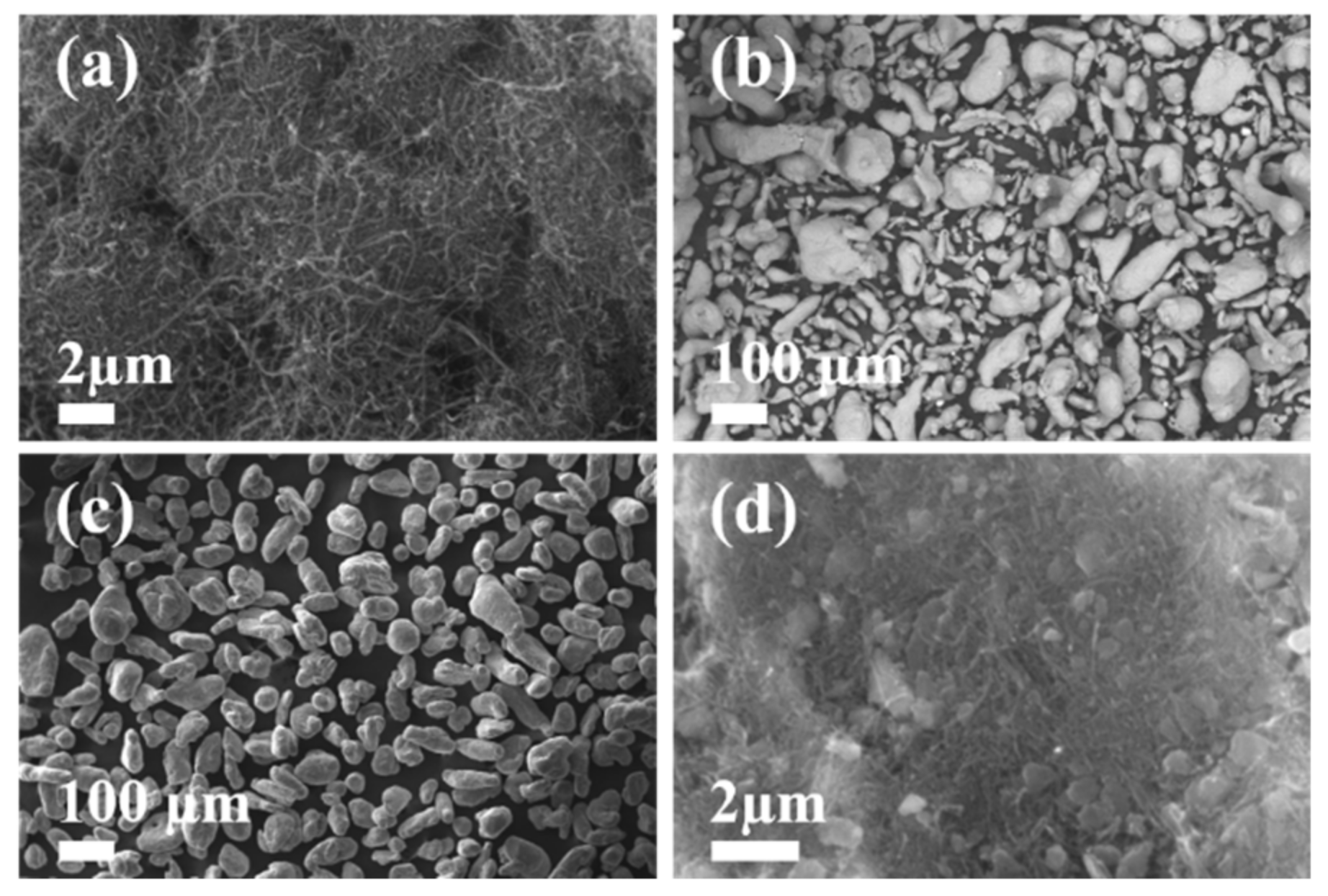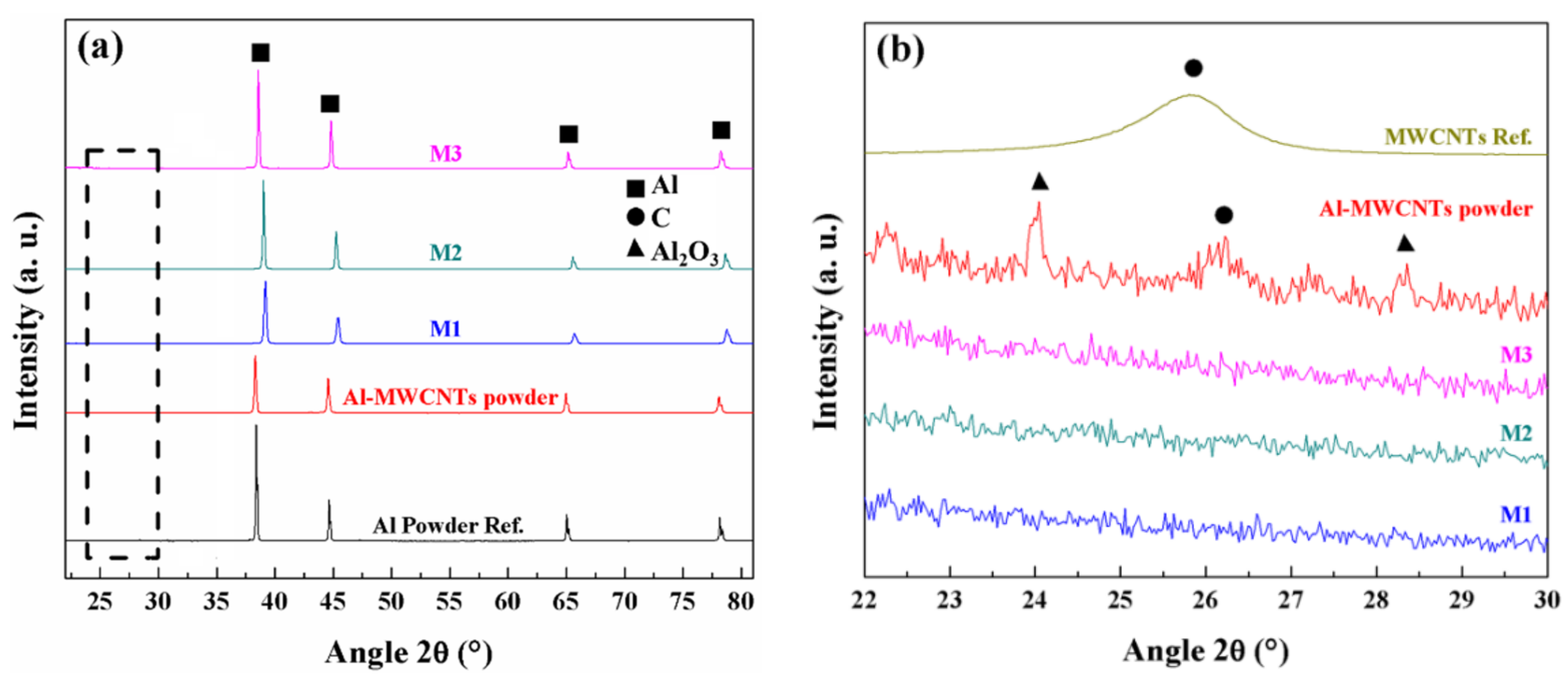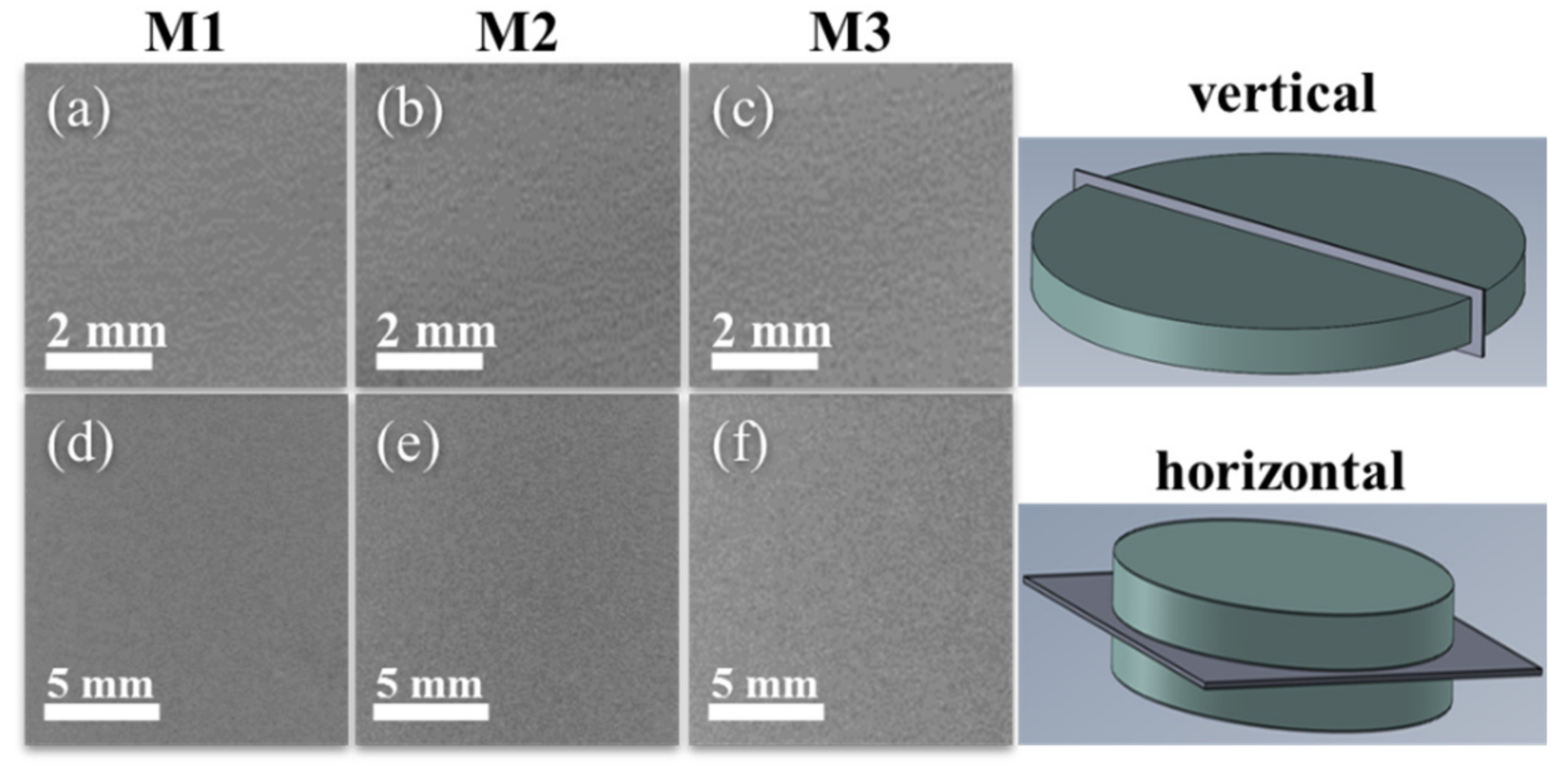Enhancement of Electrical Conductivity of Aluminum-Based Nanocomposite Produced by Spark Plasma Sintering
Abstract
1. Introduction
2. Materials and Methods
2.1. Al-Based MWCNTs Nanocomposite Powder Preparation
2.2. Sintering Consolidation of the Al-Based MWCNTs Specimens
2.3. Scanning Electron Microscopy (SEM)
2.4. Densification
2.5. Tomography
2.6. X-ray Diffraction (XRD) Measuremrnts
2.7. Electrical Conductivity Tests
3. Results and Discussion
3.1. Cross-Sectional Morphology and EDS Elemental Mapping Analysis
3.2. Crystallite Size of Sintered Al-Based MWCNT Nanocomposites
3.3. Densification Behavior and Porosity of Sintered Al-Based MWCNT Nanocomposites
3.4. Electrical Conductivity
4. Conclusions
- Ball-milling process modifies Al particle morphology and size enhancing powder particle interaction and MWCNTs bonding that allows to produce high densification SPS process samples.
- A good dispersion of MWCNTs along the produced samples is confirmed by EDS elemental mapping images.
- After the fabrication of the composite samples M1, M2, and M3 via SPS process, the crystallite size of the ball-milled Al-MWCNTs powders changes from 30 nm to an average value of 43 nm, which is an indication of the MWCNTs bonding into the boundaries of the aluminum grains.
- The electrical conductivity value, in all sintered samples, improves around 40% IACS which is attributed to the effective multi-wall-carbon-nanotubes network formed within the nanocomposite material, that promotes electron transport.
Author Contributions
Funding
Acknowledgments
Conflicts of Interest
References
- Mohammed, S.M.A.K.; Chen, D.L. Carbon Nanotube-Reinforced Aluminum Matrix Composites. Adv. Eng. Mater. 2020, 22, 1901176. [Google Scholar] [CrossRef]
- Veillère, A.; Kurita, H.; Kawasaki, A.; Lu, Y.; Heintz, J.-M.; Silvain, J.-F. Aluminum/Carbon Composites Materials Fabricated by the Powder Metallurgy Process. Materials 2019, 12, 4030. [Google Scholar] [CrossRef] [PubMed]
- Kumar Sharma, A.; Bhandari, R.; Aherwar, A.; Rimašauskienė, R.; Pinca-Bretotean, C. A study of advancement in application opportunities of aluminum metal matrix composites. Mater. Today Proc. 2020, 26, 2419–2424. [Google Scholar] [CrossRef]
- Bradbury, C.R.; Gomon, J.K.; Kollo, L.; Kwon, H.; Leparoux, M. Hardness of Multi Wall Carbon Nanotubes reinforced aluminium matrix composites. J. Alloys Compd. 2014, 585, 362–367. [Google Scholar] [CrossRef]
- Singla, D.; Amulya, K.; Murtaza, Q. CNT Reinforced Aluminium Matrix Composite—A Review. In Materials Today: Proceedings; Elsevier Ltd.: Amsterdam, The Netherlands, 2015; Volume 2, pp. 2886–2895. [Google Scholar]
- Mavhungu, S.T.; Akinlabi, E.T.; Onitiri, M.A.; Varachia, F.M. Aluminum Matrix Composites for Industrial Use: Advances and Trends. Procedia Manuf. 2017, 7, 178–182. [Google Scholar] [CrossRef]
- Liu, Z.Y.; Xu, S.J.; Xiao, B.L.; Xue, P.; Wang, W.G.; Ma, Z.Y. Effect of ball-milling time on mechanical properties of carbon nanotubes reinforced aluminum matrix composites. Compos. Part A Appl. Sci. Manuf. 2012, 43, 2161–2168. [Google Scholar] [CrossRef]
- Sajeeb Rahiman, A.H.; Robinson Smart, D.S. Aluminium Carbon Nanotube Composites—A Review on Latest Approaches; Lecture Notes on Multidisciplinary Industrial Engineering; Antony, K., Davim, J.P., Eds.; Springer International Publishing: Cham, Switzerland, 2018; pp. 387–393. [Google Scholar]
- Ajayan, P.M.; Ebbesen, T.W. Nanometre-size tubes of carbon. Rep. Prog. Phys. 1997, 60, 1025–1062. [Google Scholar] [CrossRef]
- Dai, H. Carbon nanotubes: Opportunities and challenges. Surf. Sci. 2002, 500, 218–241. [Google Scholar] [CrossRef]
- De Volder, M.F.L.; Tawfick, S.H.; Baughman, R.H.; Hart, A.J. Carbon Nanotubes: Present and Future Commercial Applications. Science 2013, 339, 535–539. [Google Scholar] [CrossRef]
- Xiao, J.R.; Gama, B.A.; Gillespie, J.W. An analytical molecular structural mechanics model for the mechanical properties of carbon nanotubes. Int. J. Solids Struct. 2005, 42, 3075–3092. [Google Scholar] [CrossRef]
- Deng, L.; Young, R.J.; Kinloch, I.A.; Sun, R.; Zhang, G.; Noé, L.; Monthioux, M. Coefficient of thermal expansion of carbon nanotubes measured by Raman spectroscopy. Appl. Phys. Lett. 2014, 104, 051907. [Google Scholar] [CrossRef]
- Esawi, A.M.K.; Morsi, K.; Sayed, A.; Taher, M.; Lanka, S. The influence of carbon nanotube (CNT) morphology and diameter on the processing and properties of CNT-reinforced aluminium composites. Compos. Part A Appl. Sci. Manuf. 2011, 42, 234–243. [Google Scholar] [CrossRef]
- Tjong, S.C. Recent progress in the development and properties of novel metal matrix nanocomposites reinforced with carbon nanotubes and graphene nanosheets. Mater. Sci. Eng. R Rep. 2013, 74, 281–350. [Google Scholar] [CrossRef]
- Liu, Z.Y.; Zhao, K.; Xiao, B.L.; Wang, W.G.; Ma, Z.Y. Fabrication of CNT/Al composites with low damage to CNTs by a novel solution-assisted wet mixing combined with powder metallurgy processing. Mater. Des. 2016, 97, 424–430. [Google Scholar] [CrossRef]
- Fan, G.; Jiang, Y.; Tan, Z.; Guo, Q.; Xiong, D.-b.; Su, Y.; Lin, R.; Hu, L.; Li, Z.; Zhang, D. Enhanced interfacial bonding and mechanical properties in CNT/Al composites fabricated by flake powder metallurgy. Carbon N. Y. 2018, 130, 333–339. [Google Scholar] [CrossRef]
- Datsyuk, V.; Kalyva, M.; Papagelis, K.; Parthenios, J.; Tasis, D.; Siokou, A.; Kallitsis, I.; Galiotis, C. Chemical oxidation of multiwalled carbon nanotubes. Carbon N. Y. 2008, 46, 833–840. [Google Scholar] [CrossRef]
- Sharma, P.; Sharma, S.; Khanduja, D. On the Use of Ball Milling for the Production of Ceramic Powders. Mater. Manuf. Process. 2015, 30, 1370–1376. [Google Scholar] [CrossRef]
- Morsi, K.; Esawi, A.M.K.; Lanka, S.; Sayed, A.; Taher, M. Spark plasma extrusion (SPE) of ball-milled aluminum and carbon nanotube reinforced aluminum composite powders. Compos. Part A Appl. Sci. Manuf. 2010, 41, 322–326. [Google Scholar] [CrossRef]
- Saheb, N.; Iqbal, Z.; Khalil, A.; Hakeem, A.S.; Al Aqeeli, N.; Laoui, T.; Al-Qutub, A.; Kirchner, R. Spark plasma sintering of metals and metal matrix nanocomposites: A review. J. Nanomater. 2012, 2012. [Google Scholar] [CrossRef]
- Choi, H.J.; Kwon, G.B.; Lee, G.Y.; Bae, D.H. Reinforcement with carbon nanotubes in aluminum matrix composites. Scr. Mater. 2008, 59, 360–363. [Google Scholar] [CrossRef]
- Choi, H.; Shin, J.; Min, B.; Park, J.; Bae, D. Reinforcing effects of carbon nanotubes in structural aluminum matrix nanocomposites. J. Mater. Res. 2009, 24, 2610–2616. [Google Scholar] [CrossRef]
- Liu, Z.Y.; Xiao, B.L.; Wang, W.G.; Ma, Z.Y. Tensile strength and electrical conductivity of carbon nanotube reinforced aluminum matrix composites fabricated by powder metallurgy combined with friction stir processing. J. Mater. Sci. Technol. 2014, 30, 649–655. [Google Scholar] [CrossRef]
- Zhang, S.; Chen, G.; Qu, T.; Wei, J.; Yan, Y.; Liu, Q.; Zhou, M.; Zhang, G.; Zhou, Z.; Gao, H.; et al. A novel aluminum-carbon nanotubes nanocomposite with doubled strength and preserved electrical conductivity. Nano Res. 2021. [Google Scholar] [CrossRef]
- Ujah, C.O.; Popoola, A.P.I.; Popoola, O.M.; Aigbodion, V.S. Optimisation of spark plasma sintering parameters of Al-CNTs-Nb nano-composite using Taguchi Design of Experiment. Int. J. Adv. Manuf. Technol. 2019, 100, 1563–1573. [Google Scholar] [CrossRef]
- Viswanathan, V.; Laha, T.; Balani, K.; Agarwal, A.; Seal, S. Challenges and advances in nanocomposite processing techniques. Mater. Sci. Eng. R Rep. 2006, 54, 121–285. [Google Scholar] [CrossRef]
- Singh, L.K.; Bhadauria, A.; Jana, S.; Laha, T. Effect of Sintering Temperature and Heating Rate on Crystallite Size, Densification Behaviour and Mechanical Properties of Al-MWCNT Nanocomposite Consolidated via Spark Plasma Sintering. Acta Metall. Sin. (Engl. Lett.) 2018, 31, 1019–1030. [Google Scholar] [CrossRef]
- Singh, L.K.; Bhadauria, A.; Oraon, A.; Laha, T. Spark plasma sintered Al-0.5 wt% MWCNT nanocomposite: Effect of sintering pressure on the densification behavior and multi-scale mechanical properties. Diam. Relat. Mater. 2019, 91, 144–155. [Google Scholar] [CrossRef]
- Singh, L.K.; Bhadauria, A.; Laha, T. Al-MWCNT nanocomposite synthesized via spark plasma sintering: Effect of powder milling and reinforcement addition on sintering kinetics and mechanical properties. J. Mater. Res. Technol. 2019, 8, 503–512. [Google Scholar] [CrossRef]
- Ujah, C.O.; Popoola, A.P.I.; Popoola, O.M.; Aigbodion, V.S. Influence of CNTs addition on the mechanical, microstructural, and corrosion properties of Al alloy using spark plasma sintering technique. Int. J. Adv. Manuf. Technol. 2020, 106, 2961–2969. [Google Scholar] [CrossRef]
- Xu, C.L.; Wei, B.Q.; Ma, R.Z.; Liang, J.; Ma, X.K.; Wu, D.H. Fabrication of Aluminum-Carbon Nanotube Composites and Their Electrical Properties. Carbon 1999, 37, 855–858. [Google Scholar] [CrossRef]
- Ulloa-Castillo, N.A.; Martínez-Romero, O.; Hernandez-Maya, R.; Segura-Cárdenas, E.; Elías-Zúñiga, A. Spark plasma sintering of aluminum-based powders reinforced with carbon nanotubes: Investigation of electrical conductivity and hardness properties. Materials 2021, 14, 373. [Google Scholar] [CrossRef] [PubMed]
- Mote, V.; Purushotham, Y.; Dole, B. Williamson-Hall analysis in estimation of lattice strain in nanometer-sized ZnO particles. J. Theor. Appl. Phys. 2012, 6, 2–9. [Google Scholar] [CrossRef]
- Xiao, G.H.; Tao, N.R.; Lu, K. Effects of strain, strain rate and temperature on deformation twinning in a Cu–Zn alloy. Scr. Mater. 2008, 59, 975–978. [Google Scholar] [CrossRef]
- Shin, S.E.; Bae, D.H. Strengthening behavior of chopped multi-walled carbon nanotube reinforced aluminum matrix composites. Mater. Charact. 2013, 83, 170–177. [Google Scholar] [CrossRef]
- Zhbanov, A.I.; Pogorelov, E.G.; Chang, Y.C. Van der Waals interaction between two crossed carbon nanotubes. ACS Nano 2010, 4, 5937–5945. [Google Scholar] [CrossRef]
- Zare, Y.; Yop Rhee, K. Calculation of the electrical conductivity of polymer nanocomposites assuming the interphase layer surrounding carbon nanotubes. Polymers 2020, 12, 404. [Google Scholar] [CrossRef]
- Zare, Y.; Yop Rhee, K.; Park, S.J. Modeling the roles of carbon nanotubes and interphase dimensions in the conductivity of nanocomposites. Results Phys. 2009, 15, 102562. [Google Scholar] [CrossRef]
- Chen, B.; Kondoh, K. Sintering behaviors of carbon nanotubes-aluminum composite powders. Metals 2016, 6, 213. [Google Scholar] [CrossRef]





| Sample | Description | Crystallite Size (nm) | Relative Density (%) | Porosity (%) |
|---|---|---|---|---|
| Al Powder Ref. | As received | 404 | - | - |
| Al-MWCNTs Powder | Ball-milled | 30 | - | - |
| M1 | Al+MWCNTs (0.5 wt %) | 48 | 98.2 | 1.72 |
| M2 | Al+MWCNTs (0.5 wt %) | 40 | 99.7 | 0.23 |
| M3 | Al+MWCNTs (0.5wt %) | 34 | 98.8 | 1.16 |
| Sample | Resistivity (nΩ-m) | Conductivity (MS/m) | IACS (%) | ||||||
|---|---|---|---|---|---|---|---|---|---|
| Zone 1 | Zone 2 | Zone 3 | Zone 1 | Zone 2 | Zone 3 | Zone 1 | Zone 2 | Zone 3 | |
| M1 | 41.2 | 41.2 | 40.6 | 24.2 | 24.2 | 24.6 | 41.8 | 41.8 | 42.4 |
| M2 | 41.5 | 41.3 | 41.4 | 24.0 | 24.1 | 24.1 | 41.5 | 41.7 | 41.6 |
| M3 | 42.3 | 42.3 | 41.4 | 23.6 | 24.2 | 24.1 | 40.7 | 41.8 | 41.6 |
Publisher’s Note: MDPI stays neutral with regard to jurisdictional claims in published maps and institutional affiliations. |
© 2021 by the authors. Licensee MDPI, Basel, Switzerland. This article is an open access article distributed under the terms and conditions of the Creative Commons Attribution (CC BY) license (https://creativecommons.org/licenses/by/4.0/).
Share and Cite
Ulloa-Castillo, N.A.; Hernández-Maya, R.; Islas-Urbano, J.; Martínez-Romero, O.; Segura-Cárdenas, E.; Elías-Zúñiga, A. Enhancement of Electrical Conductivity of Aluminum-Based Nanocomposite Produced by Spark Plasma Sintering. Nanomaterials 2021, 11, 1150. https://doi.org/10.3390/nano11051150
Ulloa-Castillo NA, Hernández-Maya R, Islas-Urbano J, Martínez-Romero O, Segura-Cárdenas E, Elías-Zúñiga A. Enhancement of Electrical Conductivity of Aluminum-Based Nanocomposite Produced by Spark Plasma Sintering. Nanomaterials. 2021; 11(5):1150. https://doi.org/10.3390/nano11051150
Chicago/Turabian StyleUlloa-Castillo, Nicolás A., Roberto Hernández-Maya, Jorge Islas-Urbano, Oscar Martínez-Romero, Emmanuel Segura-Cárdenas, and Alex Elías-Zúñiga. 2021. "Enhancement of Electrical Conductivity of Aluminum-Based Nanocomposite Produced by Spark Plasma Sintering" Nanomaterials 11, no. 5: 1150. https://doi.org/10.3390/nano11051150
APA StyleUlloa-Castillo, N. A., Hernández-Maya, R., Islas-Urbano, J., Martínez-Romero, O., Segura-Cárdenas, E., & Elías-Zúñiga, A. (2021). Enhancement of Electrical Conductivity of Aluminum-Based Nanocomposite Produced by Spark Plasma Sintering. Nanomaterials, 11(5), 1150. https://doi.org/10.3390/nano11051150







